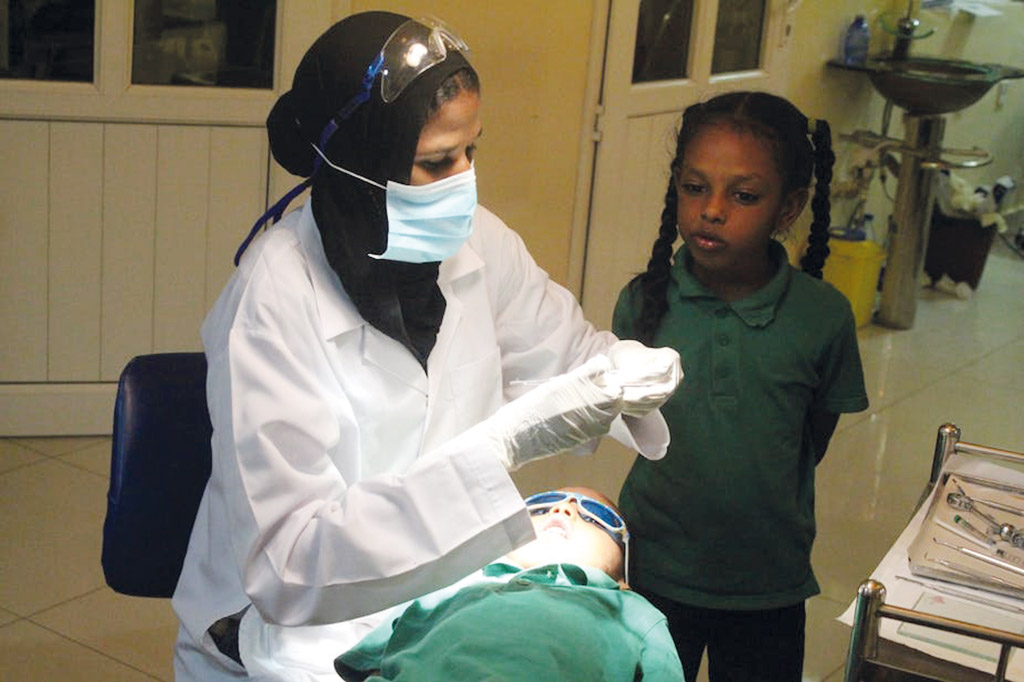Saving children’s teeth in Sudan – without anaesthetic or drills
The Hall technique, developed in Scotland, is transforming dental care at a clinic in Khartoum
Tooth decay is the most common chronic dental disease in the world, affecting 60-90 per cent of children around the world, according to the World Dental Federation. It is 20 times more common than diabetes and five times more common than asthma.
The usual way to treat the decay is to drill out the rot and then cover the tooth with a thin stainless-steel cap. It requires a local anaesthetic, lots of time, specialist skills and, for the dentist, the patience of a saint. If the child is anxious they often have to be admitted to hospital to have the work carried out under a general anaesthetic.
The only crying we heard in the clinic was when a child’s sibling got a cap and they didn’t
But consider a child living in poverty in East Africa with no running water or electricity, and the nearest dentist a day or two’s walk away. I work as a dentist in Sudan providing care for children with these exact circumstances. By the age of 12, almost all children in Sudan know what it is like to have had a tooth extracted. For a country of 40 million people, we have just eight children’s dentists.
But what if we ignore the rot, seal it by gluing a cap on the bad tooth and do nothing else? A 2006 analysis of primary care records, showed that this simple technique, known as the Hall technique, was effective in treating children in Scotland*. It works by starving the tooth-rotting germs of oxygen.
Even though this technique is supported by scientific evidence, it has been shunned by many dentists around the world as there was no randomised controlled trial proving its effectiveness compared with accepted conventional techniques. So, with colleagues at Queen Mary University of London, we set out to conduct just such a trial**. We randomly assigned 164 children to receive one of two treatments. One group received the gold standard of care. The child received a local anaesthetic and the bad tooth was then drilled to remove the decay. The cap was fitted after adjusting it to the right shape and size of the tooth – which is fiddly – and then glued. The other group received the Hall technique. We pushed the metal cap gently on to the tooth and glued it on without any injections or drilling. Capping and gluing are common to both techniques but requires a considerable adjustment in the conventional technique. None is required for the Hall technique.
The study was done at a time in Sudan when Omar al-Bashir’s brutal regime was coming to an end. Daily life was, and still is, tough. The situation affected the project on many levels. While most scientists take the internet for granted, we don’t. Blackouts are common and can last for weeks or months, so a high level of organisation is needed. Even in the capital, Khartoum, electricity and water supplies are not guaranteed.
The results of our study, published in open access journal PLOS ONE, prove that the Hall technique performs as well as the gold standard in all clinical aspects, such as the survival of the tooth, gum health, occlusion, and abscess formation, even when done by less experienced operators.
In addition to saving teeth, the technique performed as well as the gold standard in terms of the caps remaining in place over a two-year follow-up. And the children were much happier just before the treatment, just after it, and a year later. In fact, some children were demanding the caps to be fitted on their brothers and sisters. The only crying we heard in the clinic was when a child’s sibling got a cap and they didn’t.
Keeping costs low is very important for maintaining public health systems around the world, and this technique proved to be much cheaper than conventional techniques of drilling and capping. But changes in healthcare policy must be supported by evidence, and our study goes some way to providing that.
The Hall technique, if widely adopted, could have a big impact on many overstretched public health services around the world, particularly those in developing countries and those with little access to dental services, giving children a better chance of keeping their teeth.
About the author
Fadil Elamin is Honorary Senior Research Fellow, Dentistry, at Queen Mary University of London. This article first appeared at theconversation.com
* A novel technique using preformed metal crowns for managing carious primary molars in general practice – A retrospective analysis. N P T Innes, D R Stirrups, D J P Evans, N Hall & M Leggate. British Dental Journal, 2006 (Vol 200, p451–454).
**A randomised clinical trial comparing Hall vs conventional technique in placing preformed metal crowns from Sudan. Fadil Elamin, Nihal Abdelazeem, Isra Salah, Yousra Mirghani, Ferranti Wong. 3 June 2019. doi.org/10.1371/journal.pone.0217740

1 Comment
Thanks for the great post Fadil. I really enjoyed. Keep posting.
I am now in my 20’s but I wish I can go back to being a kid so that I can take care of my teeth.